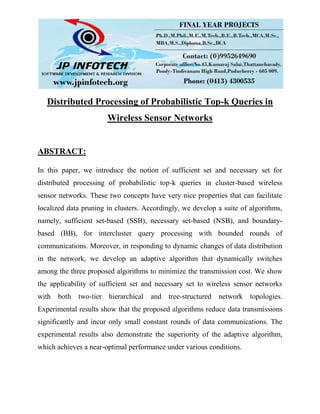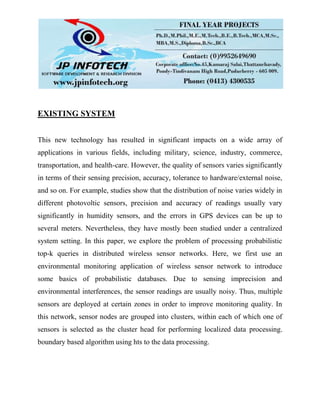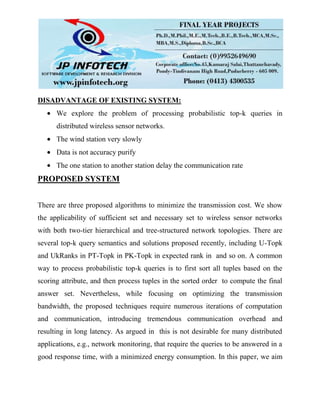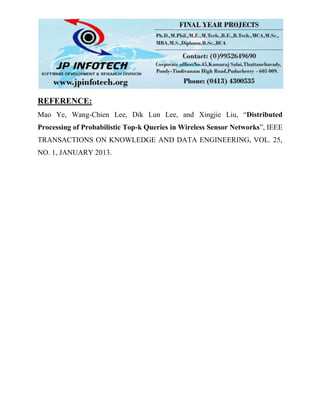Distributed processing of probabilistic top k queries in wireless sensor networks
- 1. Distributed Processing of Probabilistic Top-k Queries in Wireless Sensor Networks ABSTRACT: In this paper, we introduce the notion of sufficient set and necessary set for distributed processing of probabilistic top-k queries in cluster-based wireless sensor networks. These two concepts have very nice properties that can facilitate localized data pruning in clusters. Accordingly, we develop a suite of algorithms, namely, sufficient set-based (SSB), necessary set-based (NSB), and boundary- based (BB), for intercluster query processing with bounded rounds of communications. Moreover, in responding to dynamic changes of data distribution in the network, we develop an adaptive algorithm that dynamically switches among the three proposed algorithms to minimize the transmission cost. We show the applicability of sufficient set and necessary set to wireless sensor networks with both two-tier hierarchical and tree-structured network topologies. Experimental results show that the proposed algorithms reduce data transmissions significantly and incur only small constant rounds of data communications. The experimental results also demonstrate the superiority of the adaptive algorithm, which achieves a near-optimal performance under various conditions.
- 2. EXISTING SYSTEM This new technology has resulted in significant impacts on a wide array of applications in various fields, including military, science, industry, commerce, transportation, and health-care. However, the quality of sensors varies significantly in terms of their sensing precision, accuracy, tolerance to hardware/external noise, and so on. For example, studies show that the distribution of noise varies widely in different photovoltic sensors, precision and accuracy of readings usually vary significantly in humidity sensors, and the errors in GPS devices can be up to several meters. Nevertheless, they have mostly been studied under a centralized system setting. In this paper, we explore the problem of processing probabilistic top-k queries in distributed wireless sensor networks. Here, we first use an environmental monitoring application of wireless sensor network to introduce some basics of probabilistic databases. Due to sensing imprecision and environmental interferences, the sensor readings are usually noisy. Thus, multiple sensors are deployed at certain zones in order to improve monitoring quality. In this network, sensor nodes are grouped into clusters, within each of which one of sensors is selected as the cluster head for performing localized data processing. boundary based algorithm using hts to the data processing.
- 3. DISADVANTAGE OF EXISTING SYSTEM: We explore the problem of processing probabilistic top-k queries in distributed wireless sensor networks. The wind station very slowly Data is not accuracy purify The one station to another station delay the communication rate PROPOSED SYSTEM There are three proposed algorithms to minimize the transmission cost. We show the applicability of sufficient set and necessary set to wireless sensor networks with both two-tier hierarchical and tree-structured network topologies. There are several top-k query semantics and solutions proposed recently, including U-Topk and UkRanks in PT-Topk in PK-Topk in expected rank in and so on. A common way to process probabilistic top-k queries is to first sort all tuples based on the scoring attribute, and then process tuples in the sorted order to compute the final answer set. Nevertheless, while focusing on optimizing the transmission bandwidth, the proposed techniques require numerous iterations of computation and communication, introducing tremendous communication overhead and resulting in long latency. As argued in this is not desirable for many distributed applications, e.g., network monitoring, that require the queries to be answered in a good response time, with a minimized energy consumption. In this paper, we aim
- 4. at developing energy efficient algorithms optimized for fixed rounds of communications. ADVANTAGE OF PROPOSED SYSTEM: Additionally, NSB and BB take advantage of the skewed necessary sets and necessary boundaries among local clusters to obtain their global boundaries, respectively, which are very effective for intercluster pruning. The transmission cost increases for all algorithms because the number of tuples needed for query processing is increased. MODULES: 1. PT-Topk Query Processing 2. Sensor Networks 3. Data pruning 4. Structured network topology 5. Data transmission 6. Performance evaluation
- 5. MODULE DESCRIPTION: PT-Topk Query Processing The PT-Topk queries in a centralized uncertain database, which provides a good background for the targeted distributed processing problem. The query answer can be obtained by examining the tuples in descending ranking order from the sorted table (which is still denoted as T for simplicity). We can easily determine that the highest ranked k tuples are definitely in the answer set as long as their confidences are greater than p since their qualifications as PT-Topk answers are not dependent on the existence of any other tuples. Sensor Networks The extensive number of research work in this area has appeared in the literature. Due to the limited energy budget available at sensor nodes, the primary issue is how to develop energy-efficient techniques to reduce communication and energy costs in the networks. Approximate-based data aggregation techniques have also been proposed. The idea is to tradeoff some data quality for improved energy efficiency. Silberstein et al. develop a sampling-based approach to evaluate approximate top-k queries in wireless sensor networks. Based on statistical modeling techniques, a model-driven approach was proposed in to balance the
- 6. confidence of the query answer against the communication cost in the network. Moreover, continuous top-k queries for sensor networks have been studied in and . In addition, a distributed threshold join algorithm has been developed for top-k queries. These studies, considering no uncertain data, have a different focus from our study. Data pruning The cluster heads are responsible for generating uncertain data tuples from the collected raw sensor readings within their clusters. To answer a query, it’s natural for the cluster heads to prune redundant uncertain data tuples before delivery to the base station in order to reduce communication and energy cost. The key issue here is how to derive a compact set of tuples essential for the base station to answer the probabilistic top-k queries. Structured network topology To perform in-network query processing, a routing tree is often formed among sensor nodes and the base station. A query is issued at the root of the routing tree and propagated along the tree to all sensor nodes. Although the concepts of sufficient set and necessary set introduced earlier are based on two-tier hierarchical sensor networks, they are applicable to tree-structured sensor network.
- 7. Data transmission The total amount of data transmission as the performance metrics. Notice that, response time is another important metrics to evaluate query processing algorithms in wireless sensor networks. All of those three algorithms, i.e., SSB, NSB, and BB, perform at most two rounds of message exchange there is not much difference among SSB, NSB, and BB in terms of query response time, thus we focus on the data transmission costin the evaluation. Finally, we also conduct experiments to evaluate algorithms, SSB-T, NSB-T, and NSB-T-Opt under the tree-structured network topology. Performance evaluation The performance evaluation on the distributed algorithms for processing PT-top k queries in two-tier hierarchical cluster based wireless sensor monitoring system. As discussed, limited energy budget is a critical issue for wireless sensor network and radio transmission is the most dominate source of energy consumption. Thus, we measure the total amount of data transmission as the performance metrics. Notice that, response time is another important metrics to evaluate query processing algorithms in wireless sensor networks.
- 8. SYSTEM FLOW: Base Station Station-2 Station-6 Station-5 Station-4 Station-3 Station-1 Top-k Queries Intracluster data pruning
- 9. SYSTEM CONFIGURATION:- HARDWARE CONFIGURATION:- Processor - Pentium –IV Speed - 1.1 Ghz RAM - 256 MB(min) Hard Disk - 20 GB Key Board - Standard Windows Keyboard Mouse - Two or Three Button Mouse Monitor - SVGA SOFTWARE CONFIGURATION:- Operating System : Windows XP Programming Language : JAVA Java Version : JDK 1.6 & above.
- 10. REFERENCE: Mao Ye, Wang-Chien Lee, Dik Lun Lee, and Xingjie Liu, “Distributed Processing of Probabilistic Top-k Queries in Wireless Sensor Networks”, IEEE TRANSACTIONS ON KNOWLEDGE AND DATA ENGINEERING, VOL. 25, NO. 1, JANUARY 2013.










